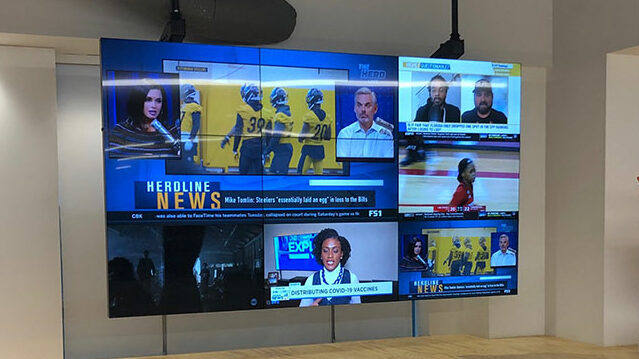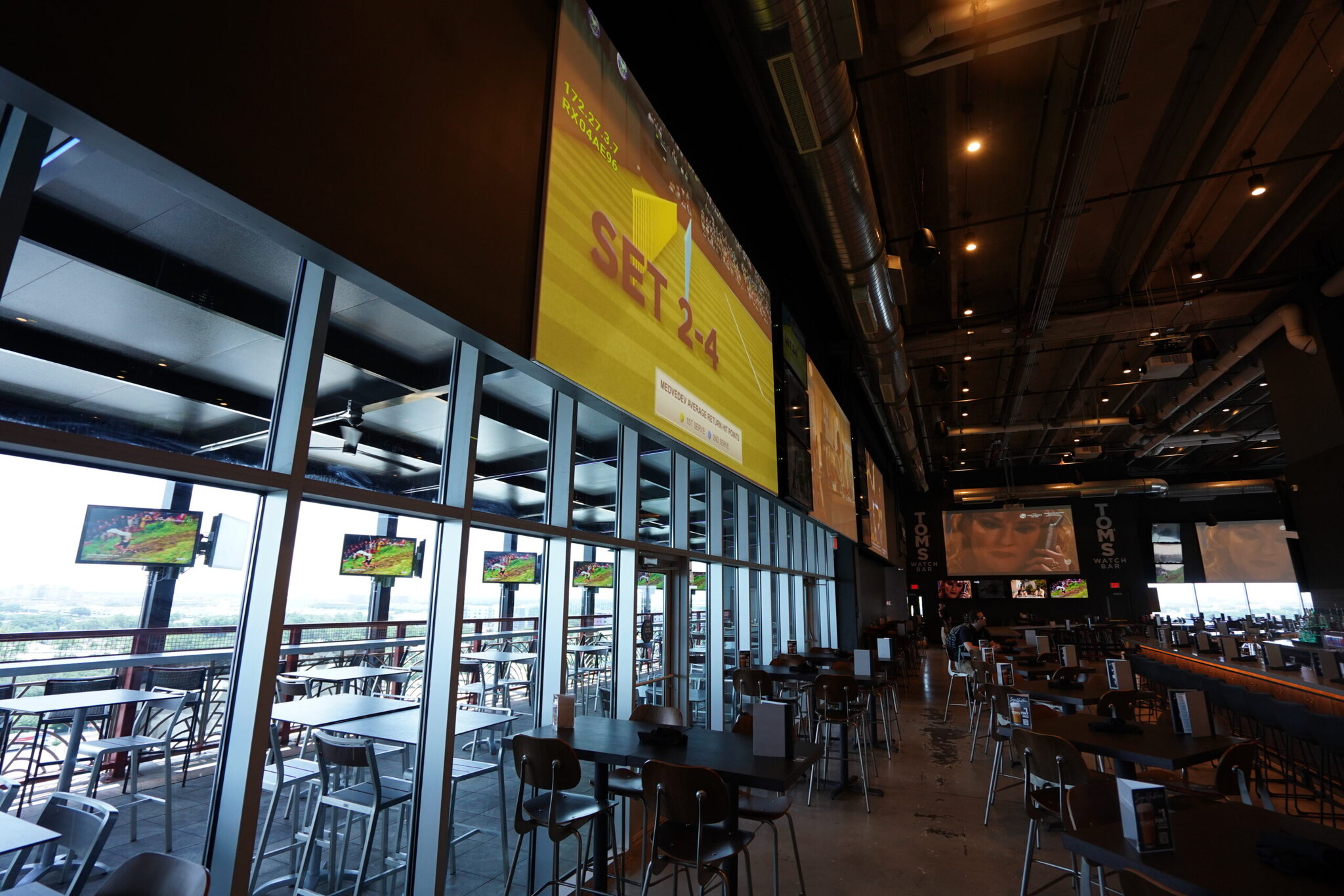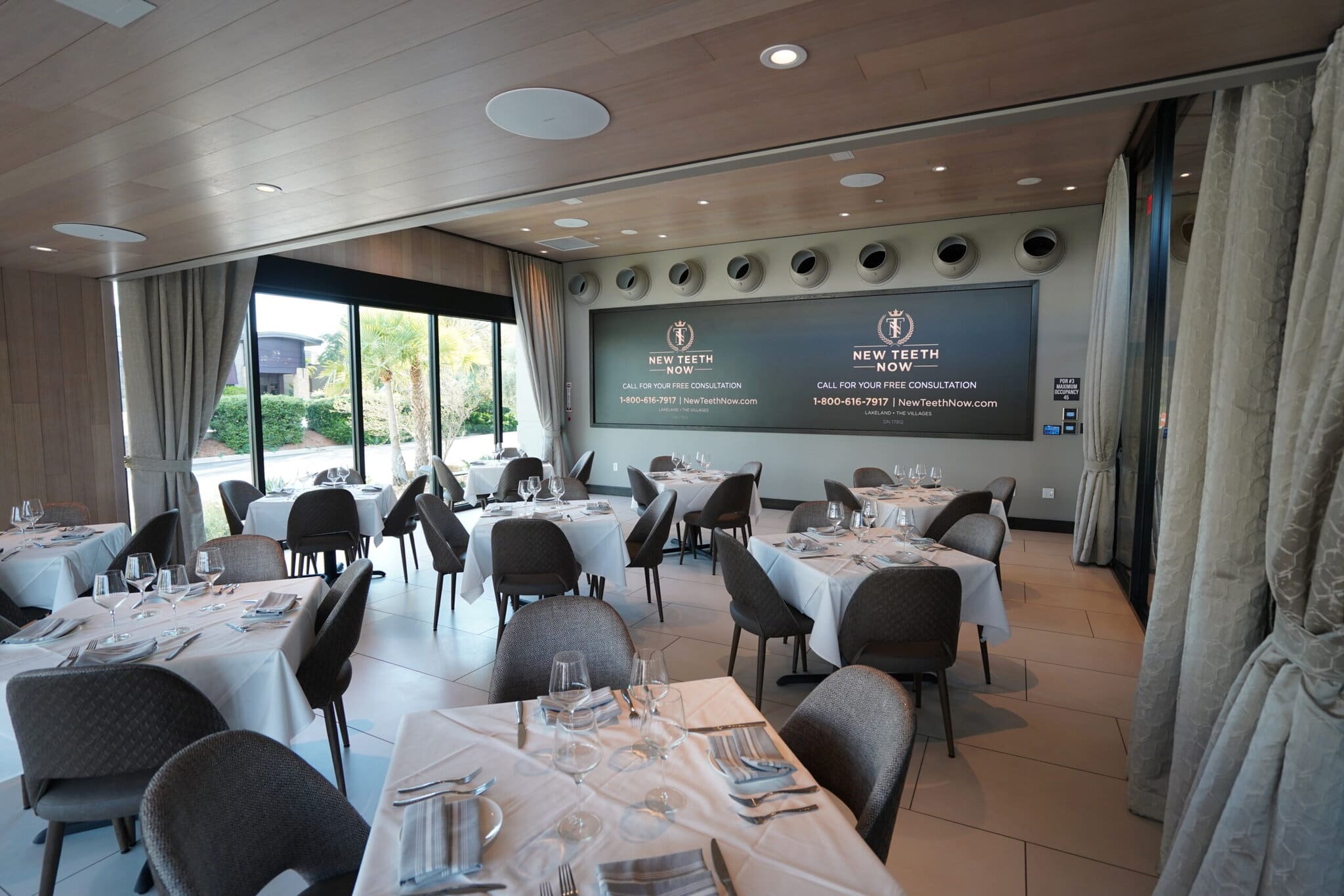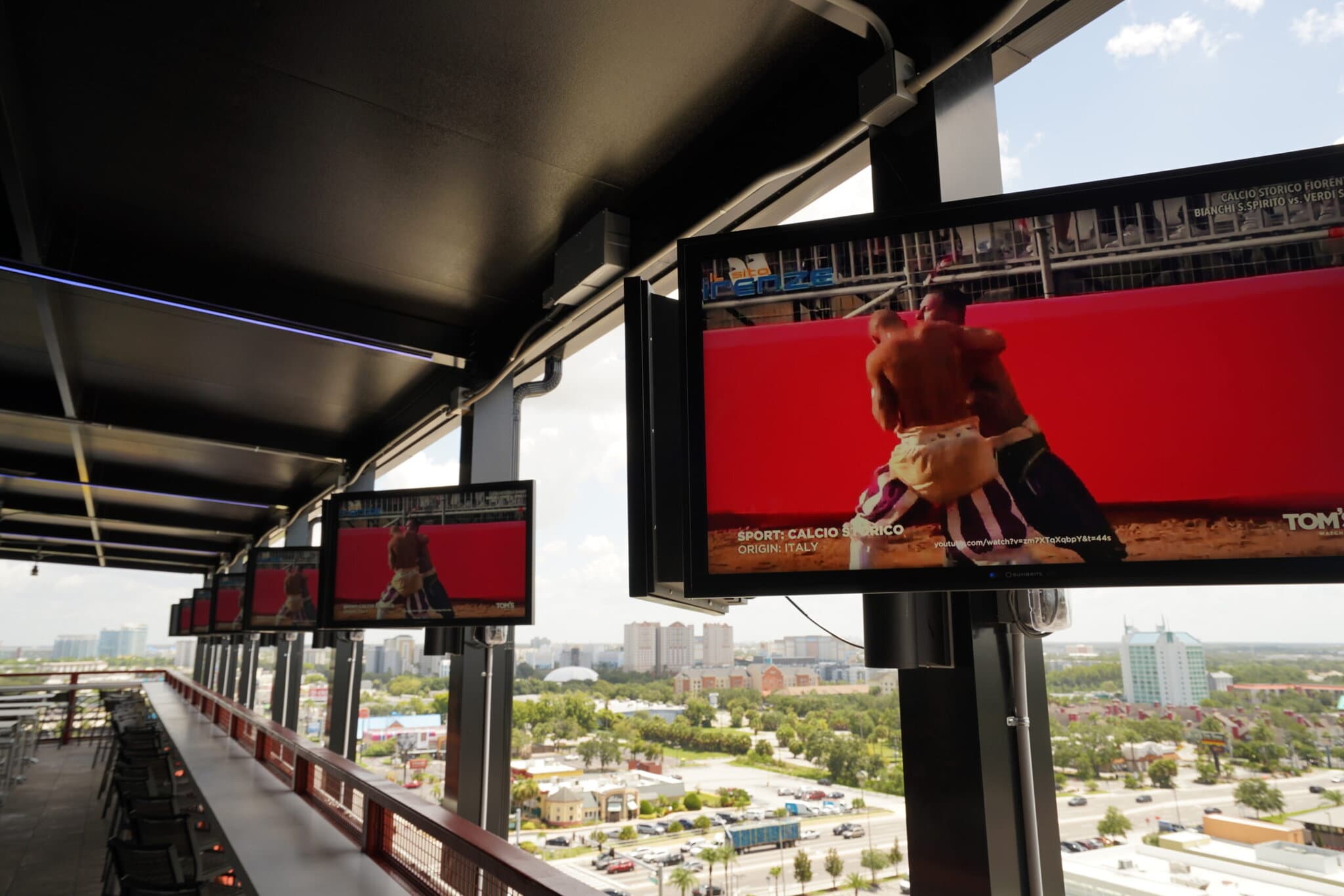Digital signage refers to display systems used to deliver dynamic content such as video, images, text, and real-time data. Commonly deployed in commercial, public, and institutional settings, digital signage serves a range of purposes—from advertising and brand communication to wayfinding and information distribution—through remotely managed content platforms.
You’ve got five seconds. That’s how long it takes for someone to walk past your business, skip your lobby screen, or zone out in your meeting space. Static signs prove inadequate, while printed posters are antiquated at this point, not to mention environmentally unfriendly.
Businesses need a better way to communicate in a world where attention spans have become shorter than that of the average goldfish. And digital signage delivers just that.
In this guide, we’ll lift the curtain on digital signage definition, how it really works, and why it’s become the standard communication tool for modern businesses across industries, including retail, hospitality, corporate, and healthcare.
What is Digital Signage?
Digital signage is a piece of technology that electronically displays images, videos, web pages, or text, often for public consumption. It can be used for information dissemination, advertising, customer engagement, brand storytelling, and wayfinding, among others.
Brief history of signage technology
Humans have been creating signs since time immemorial, the goal being to guide travelers in their journey from unchartered territories.
In ancient commerce, Greeks and Romans displayed signboards (made either of stone or terracotta) in front of their shop or used them to broadcast public events.
1910s: Fast forward to 1910, the bright neon sign was born. It was believed to have been first used in a business setting by a Parisian hairdresser in 1912, inspiring others to put up their own sign to attract customers with its glowing effects.
1960s: In the mid-20th century, Hewlett-Packard (HP) introduced the first practical LED display in 1968, followed by Philips’ videocassette recorders that hit the shelves in 1972. It wasn’t until the 1990s that the term ‘digital signage’ was coined.
1990s: It was during this same period that the world saw a digital revolution unfold in earnest, with the introduction of flatscreen TVs, DVDs, home computers, mobile phones, and CMS systems to the general public.
2020s: Today, the global digital signage market size is expected to reach $54.69 billion by 2034, with a compound annual growth rate (CAGR) of 7.41% from 2025 to 2034.
Clearly, businesses continue to see today’s digital signage as an indispensable tool for marketing, information sharing, and customer service.

How Digital Signage Works
Digital signage solutions might look sleek and effortless on the surface, but beneath them are a carefully orchestrated system of tech working synergistically together.
To really understand how digital signage functions, let’s come to grips with its three key components:
- Digital signage hardware
- Digital signage software
- Digital signage content
What is digital signage hardware?
Digital signage hardware is the physical stuff you can see and touch. Hardware includes:
- Displays: These are basically the screens. You can choose between LCD and LED as your main backlighting options (more on this later) to show your digital content. They can range from small tablets to massive video walls.
- Media Players: Consider these the brains behind the display screen. They store and deliver the content to your displays. Some are built into the screens; others are separate devices.
- Mounts and Enclosures: These support or protect the displays, especially in public spaces or outdoor environments where it can be susceptible to damage.
- Sensors and Accessories: Add-ons like motion sensors, cameras, or touchscreens enhance interactivity, connectivity, and personalization.
What is digital signage software?
This is what powers the content behind the scenes. A digital signage software solution or its Content Management System (CMS) lets you:
- Upload and manage digital media files
- Schedule when and where content appears
- Control multiple screens or locations remotely
- Monitor performance and uptime
- Integrate with data feeds, POS systems, or social media
Some digital sign software, like BrightSign, is cloud-based (meaning you access it through a browser), while others are installed locally on your network. Either way, the best digital signage system is user-friendly, flexible, and scalable.
What is digital signage content?
This is what people actually see—the graphics, videos, animations, text, or live data on the digital screen. Your display content can be used for the following purposes:
- Promotional (ads, offers, upsells)
- Informational (directions, schedules, wait times)
- Interactive (touchscreen menus, wayfinding, check-ins)
- Entertaining (videos, social feeds, trivia, inspirational quotes)
Good multimedia content is visually appealing, regularly updated, and relevant to your audience. It’s what turns your hardware and software investment into a real and even lucrative communication tool.
Benefits of Digital Signage Solutions
From burgeoning coffee shops to sprawling hotels, businesses just like yours can benefit enormously from investing in digital signage screens for the following reasons:
Enhanced customer engagement
Digital signage is an attention grabber. A quick-service restaurant digital signage can swap out a static menu board for an animated one that highlights daily combos with sizzling visuals. Done right, you can expect more customers to start ordering the featured item. A hotel lobby can also use an interactive touchscreen kiosk for guests to explore amenities and nearby attractions.
Real-time content updates
Things change fast. Maybe your signage should, too. A retail store can switch out morning coffee promos for afternoon snack specials without printing a single sign. A university can push out weather alerts or room changes instantly across campus. Being able to make updates in real time means you’re always in control of what your audience sees when they see it.
Cost-effectiveness
Let’s say a retail chain spends thousands every season updating window posters. With digital signage, they can roll out promotions chain-wide with a single upload. There’s no printing, shipping, or labor costs necessary. For a conference center, the ability to change event schedules across 30 meeting rooms with one click saves both time and sanity. It’s a huge, upfront investment, but the long-term savings (and sanity points) are legit.
Boosted brand perception and professionalism
Walk into a corporate office where a crisp video wall displays welcome messages, live news, and key company metrics… It feels polished as well as intentional. The same goes for retail: high-quality digital displays in storefronts convey innovation. Even a doctor’s office can feel more modern and trustworthy with waiting room screens sharing health tips and basic appointment info.
Data-backed decisions and analytics
Many digital signage platforms collect data. A museum might track how long visitors spend interacting with a touchscreen exhibit. A retail store can test which promotions perform best by pairing signage data with POS systems. Over time, this helps tailor content more effectively. You’re learning from your audience and refining your message in real time.

Types of Digital Signage Displays
Choosing the right type of digital display all comes down to your environment, goals, and audience. The most common types include LCD and LED digital signage, as well as indoor and outdoor electronic displays.
LCD vs. LED Screens
Businesses often choose between LCD and LED digital displays. Let’s wrap our heads around which option is best for you in terms of reliability, use cases, costing, etc.
LCD (Liquid Crystal Display)
LCD screens are hands down the more economical choice. They offer excellent image and color quality with uniform backlighting, especially for indoor environments (offices, retail shops, and schools). The caveat is, they don’t handle bright sunlight well and can look washed out in high-glare areas.
Best for: Budget-friendly indoor signage like restaurant menu boards, directories, or employee communications.
LED (Light Emitting Diode)
LEDs are brighter, more durable than LCDs, and are ideal for establishments and institutions with high-visibility needs. They perform well as outdoor displays, hold up against harsh lighting conditions, and scale easily into large formats (billboards or arena signage). Some high-end indoor applications also use LEDs for dramatic effect.
Best for: Outdoor signage, large video walls, and high-traffic environments where brightness and durability matter.
For a comprehensive side-by-side comparison, refer to this table:
| Feature | LCD | LED |
| Brightness | Moderate; best indoors | Very bright; ideal for outdoor and window-facing displays |
| Contrast | Decent, but backlight can cause light bleed | Better contrast than LCD |
| Color accuracy | Good, varies by panel quality | Very good, especially with full-array or direct LED |
| Viewing angles | Narrower; image can fade off-center | Wider than LCD |
| Durability | Reliable in indoor environments | Highly durable and weather-resistant for outdoor use |
| Thickness | Moderate; needs backlight | Similar to LCD; slimmer with edge-lit designs |
| Power consumption | Moderate | More energy efficient |
| Best use case | Menu boards, office displays, budget-friendly environments | Billboards, outdoor advertising, high-traffic commercial areas |
| Cost | The more affordable option | Mid-range; higher than LCD |
Indoor vs. Outdoor Digital Signage
Where your screen needs to be stationed at makes a big difference. Indoor and outdoor signage face totally different conditions and require different setups to work their wonders.
Indoor Displays
These don’t exactly need to deal with harsh environmental elements, so the focus is on pixel quality, design integration, and screen resolution. They’re often used in hotel lobbies, conference rooms, shopping malls, and corporate environments.
Outdoor Displays
These are built tough with weatherproof enclosures, higher brightness (up to 2,400 nits), anti-glare coatings, and temperature controls to prevent overheating or freezing. Placement also matters: sun exposure, viewing angles, and accessibility should all factor into your choice.
Quick tip: Don’t use an indoor display outdoors even if it’s under an awning. Moisture, dust, and sunlight will almost always prevail.
Interactive and Touchscreen Displays
If you fancy something your target audience can interact with and make a great impression, these displays go beyond exhibiting content as they invite people to engage with it themselves. A perfect example would be a digital concierge in a hotel, which guests can use for booking reservations and room services. Other examples include a wayfinding map in a hospital and a self-order kiosk in a restaurant.
Video Walls and Large Format Displays
Video walls are made up of multiple displays tiled together to form one colossal screen, or to showcase multiple content feeds all at the same time. Video walls can also be seamless through LED tiles or with small bezels via the use of LCD panels. Undoubtedly, video walls are a showstopper that businesses can leverage to make a bold statement or slogan in highly frequented areas.
Mobile Digital Signage and Pop-Up Displays
If you just need one for a particular event, say a trade show exhibit or a seasonal promotion, mobile displays are quite easy to set up and move. These can be wheeled into place, folded up for transport, or mounted in a vehicle. Some even run on battery power or solar so it’s more convenient and energy-efficient.

Digital Signage Content Strategies
Creating great content means delivering the right message, in the right format, at the right time. Here’s how to achieve just that.
Display types of content that actually work
You’ve got options. But the kind of content that performs best usually falls under these five categories:
- Promotions and discounts: Time-sensitive offers that drive urgency or FOMO. Think: “Happy Hour from 4–6 PM” or “20% off this weekend only.”
- Announcements and schedules: Perfect for the hospitality industry, offices, or events. Keep guests or staff in the loop with updated agendas, meeting times, or special notices.
- Live feeds: Integrate social media posts, news tickers, or weather updates to keep content fresh, varied, and relevant.
- Branded video and animations: Short, punchy clips build brand awareness and look polished. Bonus: Motion draws the eye.
- User-generated content: Display real customer reviews, check-ins, or photo walls. People love seeing real humans on screen (especially themselves!).
Implement scheduling and dayparting
Showing the same message all day is a missed business opportunity. Scheduling your content based on time of day—or dayparting—can dramatically improve relevancy and engagement.
- Morning – Show coffee specials, traffic alerts, or motivational quotes.
- Afternoon – Push lunch promos, meeting room schedules, or product information.
- Evening – Highlight happy hours, event reminders, or closing announcements.
This works tremendously well in environments like restaurants, offices, and hotels where your audience’s needs shift throughout the day.
Use dynamic and interactive content
You don’t have to stick with passive content. Interactive signage is where things get exciting:
- Add QR codes so customers can act on offers immediately (no app download required).
- Use touchscreens to let users find their way, explore menus, or customize services.
- Implement motion sensors or AI-triggered responses so content changes when someone walks by or stands in front of the screen.
The more personalized and responsive the experience, the more likely people are to engage.
Integrate branding and design principles
Even the best technology won’t save you from horrible design. Keep content visually clean, presentable, on-point, and on-brand:
- Take screen placement into consideration too; what works up close won’t work across a busy lobby.
- Stick to your brand’s colors, fonts, and tone of voice.
- Use motion sparingly as too much animation can overwhelm users/viewers.
- Design with readability in mind. Think big text, short messages, and strong contrast.
Digital Signage Applications in Different Industries
Here’s how digital signage flexes to meet the needs of totally different industries (and why that flexibility matters).
Hospitality and Hotels
In the hospitality world, digital signage helps set the vibe the moment a guest enters the premises. The hotel lobby can have a large screen that welcomes guests by name or even shows the weather forecast for the day. Near the elevators, screens can offer rotating resto recommendations or showcase spa deals.
Resorts use interactive digital signage to help guests book excursions, while conference centers list daily agendas and meeting room assignments. Having a digital concierge on every floor is peak customer service.
Corporate Offices and Campuses
For corporate spaces, electronic signage improves internal communication. In the break room you can put up a screen highlighting top-performing teams or display real-time company KPIs. In lobbies or shared areas, businesses show welcome messages for clients or live news feeds.
Larger campuses use digital wayfinding screens and digital directories to help employees or visitors navigate buildings, especially in hybrid work environments where not everyone’s in the office every day.
Retail and Quick-Service Restaurants (QSRs)
Digital sign is the silent salesperson that never sleeps in retail. A shoe store might run looping videos of new arrivals or style guides, while an apparel shop promotes flash sales or in-store events.
For QSRs, digital menu boards speed up ordering by clearly displaying item images, pricing, and daily specials. A burger place could show breakfast combos in the morning, lunch deals by noon, and dessert promos by dinner. All without anyone lifting a finger.
Education and Healthcare
On school campuses, digital signage supports both safety and communication. Interactive directories guide students to classrooms. Daily announcements, club meetings, or cafeteria menus rotate on hallway displays. During emergencies, screens can instantly broadcast alerts and evacuation instructions.
In healthcare settings, digital signage helps patients navigate complex hospital layouts with wayfinding kiosks. It also improves the waiting room experience by displaying estimated wait times, wellness tips, or calming visuals. It reduces perceived wait time and, by extension, improves patient satisfaction.

Digital Signage Challenges and Considerations
Digital signage helps in a lot of ways, but there are a few real-world challenges to think through before you hire professional AV installers to start mounting screens. Here’s what you’ll want to watch out for (and how to avoid common mistakes).
Initial investment and budgeting
Digital signage isn’t exactly cheap. Between the displays, media players, CMS licenses, installation, and custom content creation, costs can add up quickly. A single screen setup might be affordable, but outfitting an entire hotel lobby or corporate campus is a serious investment.
That said, many businesses see returns through improved customer engagement, streamlined communication, and even ad revenue. Still, budgeting wisely from the start is utterly important. Know what you need now and what you’ll want to scale down the road.
Content overload and viewer fatigue
Just because you can show a dozen messages at once doesn’t mean you should even consider doing it. One of the surefire ways to lose viewer attention is clutter. Too many messages, too fast transitions, or nonstop flashing animations. They may just annoy your viewers instead of impressing them.
Rotate content based on time of day or audience type, and keep things fresh with simple, high-impact visuals. Less noise = more attention.
Technical setup and maintenance
Even the fanciest screen won’t help you if it’s glitching. As such, consider these your non-negotiables: reliable digital signage network, clean cable management, and stable power sources. And yes, things will need maintenance. Dust, screen burn-in, software updates, or even a reboot here and there are part of the deal. For outside signage, weatherproofing is a must.
| PRO TIP: Choose experienced AV experts who have previously worked on high-value projects within your industry. This guarantees they’re already knowledgeable about the quirks, challenges, and expectations that come with your space.
Content management complexity
If you’re managing multiple locations or dozens of screens, content scheduling can get pretty complicated fast. Especially if your CMS isn’t intuitive. You need to take into consideration who’s in charge of updates, how often should content change, and whether you’re syncing it with promotions or external systems.
Needless to say, it goes beyond just uploading files. You need a plan for content governance, version control, and scheduling rules to steer clear of screen chaos. But templates, user permissions, and solid CMS training are what turn a messy system into a smooth, scalable operation.
Privacy and compliance
In some industries—healthcare or education—it’s not sufficient that digital signage looks fantastic. It’s equally important, if not more, that it satisfies strict privacy guidelines. For instance, showing a patient’s protected health information in the waiting room without authorization violates HIPAA regulations, which can result in exorbitant fines. Even retail environments need to think about customer data if they’re using interactive displays or AI personalization. Always see to it that your setup complies with local ordinances and internal compliance standards.
How to Get Started with Digital Signage
If you’re new to digital signage, the whole setup might feel a tad too much to handle. Let’s tackle the practical stuff here: what to ask, what to plan for, and how to choose the right partner so your signage actually works for your growing organizational needs.
Questions to ask before investing
Take a step back and ask yourself these questions as part of your decision making process.
- What’s the core purpose? You need to determine if it’s mainly intended for wayfinding, promotion, internal communication, or all of the above.
- Who’s your audience? Customers, employees, guests—each group expects different messaging and delivery.
- What sort of content will you actually show? It’s easy to overestimate how much video or dynamic content you’ll use.
- Do you need to scale later? It’s wise to start with a few screens. But if you plan to expand, it’s wiser to choose the digital signage technology that grows alongside your business.
These questions help narrow your options and avoid buying more—or less—than you really need.
Choosing the right digital signage partner
A solid digital signage company does more than sell screens and bulky equipment. They guide you through the full experience.
- Understand deployment process. Will they handle networking, mounting, and CMS setup? Or will that responsibility fall on your IT team?
- Look for verifiable experience. Visit their website and look for case studies that prove they can handle complex installations or multi-site rollouts.
- Prioritize customization. Your signage should reflect your brand, not just a plug-and-play template.
- Ask about long-term support. Hardware fails. Staff changes. You’ll want a team that picks up the phone six months in and is not only accessible during installation.
Digital Signage FAQs
What is the goal of digital signage?
The goal of digital signage is to communicate information in a dynamic, engaging way. That goal could be to advertise a product, guide someone through a space, display real-time updates, or fuel brand awareness efforts.
Who uses digital signage?
Digital signage is used by businesses and organizations across nearly every industry—hotels, bars, retail stores, corporate offices, hospitals, schools, airports, and even churches. Anyone who needs to communicate visually in a physical space can benefit from it.
What is another name for digital signage?
You might also hear digital signage referred to as electronic signage, multimedia signage, digital display, digital media signage—though “digital signage” is the most common industry term first popularized in 1990.
Where is digital signage used?
Digital signage is used just about everywhere: on hotel lobbies, inside elevators, behind fast food counters, in doctor’s offices, at airport gates, in classrooms, and even on street corners. It’s found anywhere people gather or move through where messaging or direction is helpful.
What is the advantage of digital signage?
The biggest advantages are flexibility, visibility, and engagement. Unlike printed signs, digital signage can change instantly, display dynamic content, and be tailored to specific times or audiences. Over time, it’s also more cost-effective and impactful.
How much does digital signage cost?
It depends on what you need. A basic digital signage setup—say a 32″ commercial-grade screen and a media player—can start around $500–$1,000. But as you scale up to larger displays or multi-screen video walls, costs rise accordingly. Mid-range solutions typically land in the $2,000–$5,000 range, while large-format or interactive signage can easily exceed $10,000–$20,000 when you factor in high-end displays, software licenses, installation, and content creation. There’s a wide range because the technology is so flexible. The real question is: do you want simple and functional, or jaw-dropping and immersive? There’s a setup for every budget.
What device is used for digital signage?
A digital signage setup usually includes a display screen (like an LCD, LED, or OLED monitor), a media player to run the content, and a content management system to schedule and control what appears on screen.
Is digital signage a TV?
Not exactly. While it may look like a TV, commercial digital signage displays are built for longer runtimes, higher brightness, and different mounting setups. They’re also paired with media players and CMS platforms to manage content, unlike your living room television.
What is smart digital signage?
Smart digital signage refers to systems that go beyond simple playback. These often include features like audience recognition, real-time data integration, interactive elements, or AI-driven content personalization; all of which makes the signage more responsive, targeted and intelligent.
Partner With Crunchy Tech for EXPERT Digital Signage Solutions
We’ve been a trusted provider of digital signage, video wall, and other audiovisual solutions for years. We’ve worked with hoteliers, retailers, office managers, sports bar owners—you name it. What they all have in common? They needed a dependable partner who understood the space, the audience, and the real goals behind their signage.
At Crunchy Tech, we make sure that from kickoff call to post-launch support, we build signage setups that are simple to use, last long, and designed for superior impact.
Need help figuring out what’s possible in your space? Let’s talk and we’ll walk you through it.
